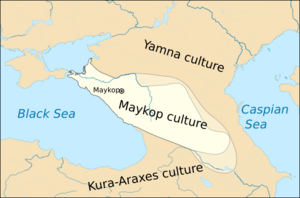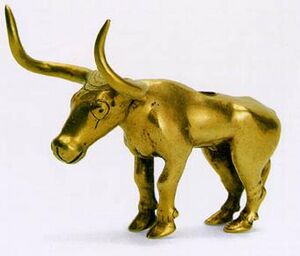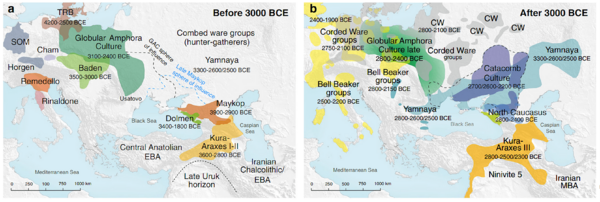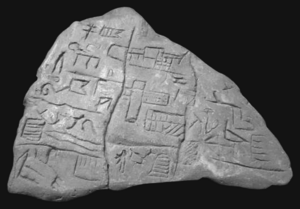Maykop culture facts for kids
 |
|
| Alternative names | Maikop, Majkop |
|---|---|
| Geographical range | Eurasian Steppe |
| Period | Bronze Age |
| Dates | c. 3700 BC – 3000 BC |
| Preceded by | Darkveti-Meshoko |
| Followed by | Yamna culture, Novosvobodnaya culture |
The Maykop culture (pronounced My-kop) was an important group of people who lived during the Bronze Age. They lived in the western Caucasus region from about 3700 BC to 3000 BC. This time was before written history.
The Maykop culture stretched from the Taman Peninsula to near modern Dagestan. It also went south to the Kura River. The culture is named after a special royal burial site. This site is called the Maykop kurgan and is in the Kuban River valley.
Scientists have studied ancient DNA from the Maykop people. They found that these people likely came from the south, from a place called Imereti. They were related to early farmers known as the Darkveti-Meshoko culture. These farmers were the first to settle north of the Caucasus mountains. The Maykop culture is thought to be linked to the start of the Northwest Caucasian language family.
Contents
Where the Maykop Culture Lived
The Maykop culture lived next to other important groups. To the south, they bordered the Kura–Araxes culture. This culture lived from about 3500 BC to 2200 BC. It was in the Armenian Plateau and seemed to influence the Maykop people.
To the north was the Yamna culture, which included the Novotitarovskaya culture. The Maykop and Yamna cultures lived in some of the same areas. The Maykop culture also existed at the same time as the late Uruk period in Mesopotamia.
The Kuban River was important for the Maykop people. It was easy to travel on this river. It connected them through the Sea of Azov to the Yamna culture's land. This was along the Don and Donets River systems. The Maykop culture was in a good spot for trading with areas like central Ukraine.
Recently, similar objects to those from Maykop have been found. These were found during digs at an ancient city called Tell Khazneh in northern Syria. This city was built around 4000 BC.
Scientists use radiocarbon dating to find the age of Maykop sites. These dates show the culture existed from about 3950 BC to 2980 BC.
After the Leyla-Tepe culture was found in the 1980s, people saw links to the Maykop culture. The Leyla-Tepe culture was from the Chalcolithic era. Its people lived on the southern slopes of the Central Caucasus. This is in modern Azerbaijan, from 4350 BC to 4000 BC. Similar jar burials are found in Western Georgia.
The Leyla-Tepe culture also has links to sites from the Ubaid period in Eastern Anatolia. Their homes were often made of mud bricks and packed closely together. Some experts think the Leyla-Tepe people might have started the Maykop culture.
In 2010, nearly 200 Bronze Age sites were found. They stretched over 60 miles from the Kuban River to Nalchik. These sites were high up in the mountains. They all looked similar, with an oval courtyard in the middle. Roads connected these sites.
Maykop Daily Life and Art

The Maykop culture was very rich in gold and silver. A historian named Hansen (2014) wrote: "The Maykop Culture in the northern Caucasus was at the same time as the Kura-Araxes Culture in the south of the Caucasus and the Uruk period in Mesopotamia. The finds in the Maykop kurgan (burial mound) and other kurgans of the Maykop Culture are still seen as special today. More than 7000 gold objects and about 1000 silver objects are known. Nowhere else in the Early Bronze Age world of the second half of the 4th millennium BC has such a large number of beautiful gold and silver items been found."
Art Styles
Early in the 20th century, researchers noticed a unique animal style in Maykop art. This style used animal shapes in its designs. It is thought to be much older than similar animal styles found in later cultures. These include the Scythian, Sarmatian, and Celtic styles.
The Maykop culture also created petroglyphs, which are carvings on rocks. We still don't know what these carvings mean.
Horse Use
The Maykop people lived settled lives, meaning they stayed in one place. Horses were not a big part of their farm animals. They mostly raised pigs and cattle.
Archaeologists found a special type of bronze tool used for horses. It was a bronze rod with a twisted loop in the middle. This tool would connect to the horse's bridle and straps. It helped control the horse.
Some of the oldest wagon wheels in the world were found in the Maykop area. Two solid wooden wheels from a burial mound in the Kuban region date back to the second half of the fourth millennium BC.
Farming on Terraces
The Maykop people built artificial terraces in the mountains. These were like steps cut into hillsides for farming. This shows they lived in one place and had many people. It also shows they had advanced farming and building skills.
These terraces were built around 4000 BC. Later cultures also used them for farming. Most of the pottery found on these terraces is from the Maykop period. Some is from the Scythian and Alan periods. The Maykop terraces are among the oldest in the world. They show that these people knew a lot about shaping the land for farming.
Where the Maykop People Came From
Scientists like David W. Anthony (2019) have looked at genetic studies. They suggest that the Maykop people came from the south. They were likely early farmers from western Georgia, known as the Darkveti-Meshoko culture. These people are considered a good match for the group who started the Northwest Caucasian language family.
However, the Maykop people's genes were different from those of the Yamnaya culture. The Yamnaya culture is thought to be linked to the spread of Indo-European languages. This means the Maykop people probably did not contribute much to the Yamnaya gene pool.
Influence on Others
Even if the Maykop people spoke different languages, their culture influenced early Indo-Europeans. Anthony writes that the Maykop culture had a big effect on the cultures of the steppes. The Yamnaya culture borrowed many things from Maykop. These included tools for working with metal, like daggers and axes. Wheeled vehicles might also have come to the steppes through the Maykop culture. This changed how people lived and made it possible for the Yamnaya people to be nomadic herders.
Ideas from the Iranian Plateau
Some researchers, like Mariya Ivanova, believe the Maykop culture might have come from the Iranian Plateau. She notes that earlier cultures in the North Caucasus were different. Then, around the mid-4th millennium BC, the Maykop culture appeared suddenly. It brought new ideas in many areas that were not seen locally before.
Ivanova suggests that the Maykop culture's links are not to Mesopotamia. Instead, they seem to be connected to the Iranian plateau and Central Asia. This means that new ideas might have spread from Iran and Central Asia.
Discoveries in Azerbaijan
Recently, very old burial mounds (kurgans) were found at Soyuqbulaq in Azerbaijan. These kurgans date back to the early 4th millennium BC. They belong to the Leylatepe Culture.
The people who dug up these kurgans found important similarities between them and the Maykop kurgans. They believe that the Leylatepe Culture tribes moved north in the mid-fourth millennium BC. They played a key role in the rise of the Maykop Culture in the North Caucasus.
See also
- Yamnaya culture
- Cucuteni-Trypillia culture
- Varna culture
- Koban culture




